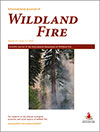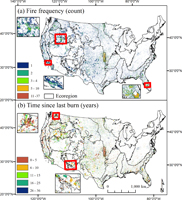International Journal of Wildland Fire
Volume 31
Number 12 2022
This paper presents the results of a large-scale analysis of news media coverage of wildfires across 30 years and three countries: the USA, Canada and Australia. It describes the wildfire-relevant topics that are most common and the interrelationships between them in each of these three contexts.
From the current study, we can learn how a conflict over access to peatland water sharing, causing annual peatland fires in the transition zone of biosphere conservation, can be turned into collaboration. The collaborative activities have reduced the village’s vulnerability to the fire.
This paper reports that burn severity and vegetation regrowth can be classified well using change vector analysis (CVA). CVA using an NDVI and NDBI approach was superior to the dNBR method as indicated by the accuracy difference between both methods.
Neighbourhood concern about bushfire in Hobart mirrors biophysical measurements of local bushfire risk. But residents underestimate the risk to their homes from fuels on their own property, and overestimate risk from nearby bushland and neighbouring properties. This research highlights the importance of communicating and facilitating collective neighbourhood-scale bushfire preparedness.
Suppression of wildfires can be dangerous and expensive. It is important that we understand the main factors influencing suppression success. Resource allocation, weather, and response times are critical factors influencing suppression because they can affect the size of the fire early on, which is the most important factor influencing containment probability.
This paper presents a technique for reducing wildfire smoke in frequently impacted communities. It combines the use of frequent air pathways into communities along with targeted fuel treatments within these pathways to reduce the duration and concentration of wildfire smoke.
We present contemporary fire history metrics for the conterminous United States (CONUS) derived from 37 years of the Landsat Burned Area Product (1984–2020) and provide examples of how these metrics can inform decision-making. Fire regimes are diverse across CONUS, but most ecoregions showed more burning on public than private land.
Warning: This article contains terms, descriptions, and opinions used for historical context that may be culturally sensitive for some readers.
Our research highlights declining burn rates in North American boreal forests during 1700–1990 but rising burn rate trends at northwestern sites during 1980–2020. We suggest that atmospheric conditions and regional changes in land use like fire exclusion and suppression were important drivers behind the multi-century declining trend.






